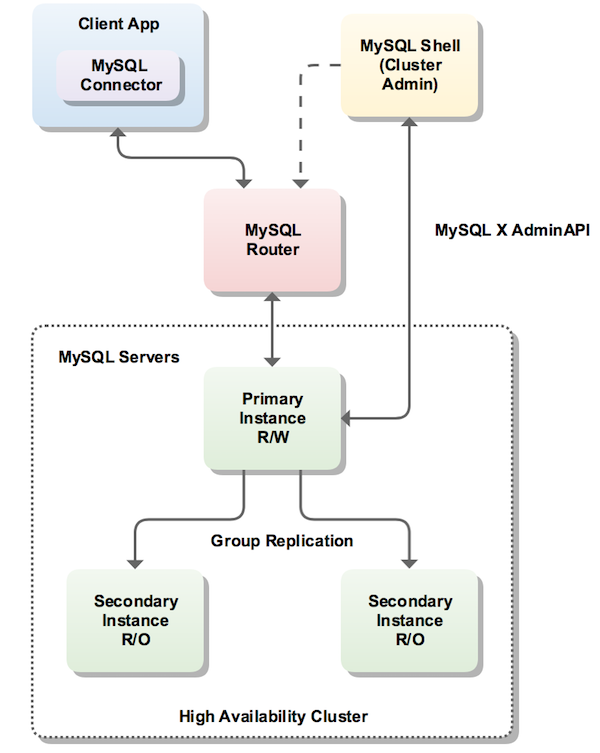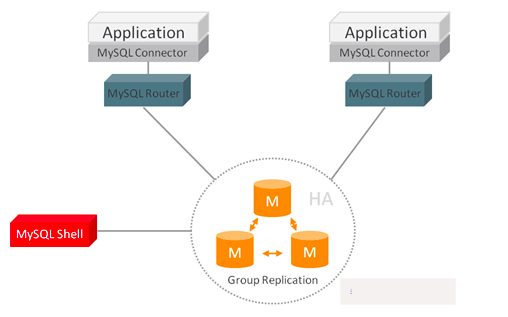之前搭建过一个Mysql Ndb cluster集群,但是mysql版本是5.7的,看到官网上mysql8的还是开发者版本,所以尝试搭建下mysql Innodb cluster集群。
- MySQL的高可用架构无论是社区还是官方,一直在技术上进行探索,这么多年提出了多种解决方案,比如
MMM,MHA,NDB Cluster,Galera Cluster,InnoDB Cluster, 腾讯的PhxSQL,MySQL Fabric,aliSQL。 NDB:基于集群的引擎-数据被自动切分并复制到数个机器上(数据节点), 适合于那些需要极高查询性能和高可用性的应用, 原来是为爱立信的电信应用设计的。NDB提供了高达99.999%的可靠性,在读操作多的应用中表现优异。 对于有很多并发写操作的应用, 还是推荐用InnoDB。- 本次部署采用
InnoDB Cluster. 每台服务器实例都运行MySQL Group Replication(冗余复制机制,内置failover) MGR有两种模式,一种是Single-Primary,一种是Multi-Primary,即单主或者多主。- 注意:
Multi-Primary模式中,所有的节点都是主节点,都可以同时被读写,看上去这似乎更好,但是因为多主的复杂性,在功能上如果设置了多主模式,则会有一些使用的限制,比如不支持Foreign Keys with Cascading Constraints。
一.工作原理
MySQL InnoDB集群提供了一个集成的,本地的,HA解决方案。Mysq Innodb Cluster是利用组复制的 pxos 协议,保障数据一致性,组复制支持单主模式和多主模式。
MySQL InnoDB集群由以下几部分组成:
- MySQL Servers with Group Replication:向集群的所有成员复制数据,同时提供容错、自动故障转移和弹性。MySQL Server 5.7.17或更高的版本。
- MySQL Router:确保客户端请求是负载平衡的,并在任何数据库故障时路由到正确的服务器。MySQL Router 2.1.3或更高的版本。
- MySQL Shell:通过内置的管理API创建及管理Innodb集群。MySQL Shell 1.0.9或更高的版本。
各个组件的关系和工作流程如下:



二.集群方案
我创建了四台虚拟机,一台用来负责管理,另外三台是主从节点,一个主,两个从。
管理节点安装mysql-shell和mysql-router,主从节点三个均安装mysql和mysql-shell
后期名称都改为:manager,master和slave1,slave2
mysql,mysql shell 和mysql router的安装包如下:
mysql:mysql-8.0.17-linux-glibc2.12-x86_64.tar.xz
mysql-shell:mysql-shell-8.0.17-linux-glibc2.12-x86-64bit.tar.gz
mysql-router:mysql-router-8.0.17-linux-glibc2.12-x86_64.tar.xz
根据官方的文档 https://dev.mysql.com/doc/refman/8.0/en/mysql-innodb-cluster-userguide.html,mysql-shell需要python环境,至少在2.7版本以上,所以在安装使用前,需要提前部署好python环境。
三.环境准备(所有服务器都要操作)
1.关闭防火墙,关闭方法因系统不同,所以不列出
2.关闭selinux(Centos),关闭方法因系统不同,所以不列出
3.修改/etc/hosts文件,将四台服务器的ip分别映射成manager,master和slave1,slave2
4.优化配置
[root@localhost ~]# cat>>/etc/sysctl.conf <<EOF fs.aio-max-nr = 1048576 fs.file-max = 681574400 kernel.shmmax = 137438953472 kernel.shmmni = 4096 kernel.sem = 250 32000 100 200 net.ipv4.ip_local_port_range = 9000 65000 net.core.rmem_default = 262144 net.core.rmem_max = 4194304 net.core.wmem_default = 262144 net.core.wmem_max = 1048586 EOF [root@localhost ~]# sysctl -p [root@localhost ~]# cat>>/etc/security/limits.conf <<EOF mysql soft nproc 65536 mysql hard nproc 65536 mysql soft nofile 65536 mysql hard nofile 65536 EOF [root@localhost ~]# cat>>/etc/pam.d/login <<EOF session required /lib/security/pam_limits.so session required pam_limits.so EOF [root@localhost ~]# cat>>/etc/profile<<EOF if [ $USER = "mysql" ]; then ulimit -u 16384 -n 65536 fi EOF [root@localhost ~]# source /etc/profile
四.在主节点安装mysql和mysql-shell
1.解压安装包
tar xvf mysql-8.0.17-linux-glibc2.12-x86_64.tar.xz tar zxvf mysql-shell-8.0.17-linux-glibc2.12-x86-64bit.tar.gz mv mysql-8.0.17-linux-glibc2.12-x86_64 /usr/local/mysql/ mv zxvf mysql-shell-8.0.17-linux-glibc2.12-x86-64bit /usr/local/mysql-shell/
2.添加用户并赋权
groupadd mysql useradd -g mysql mysql cd /usr/local/mysql/ mkdir data cd .. chown -R mysql:mysql mysql
3.修改环境变量
vi /etc/profile
.......... export PATH=$PATH:/usr/local/mysql-shell/bin/:/usr/local/mysql/bin/
source /etc/profile
4.在/etc/下增加配置文件my.cnf
[mysqld] character-set-server=utf8 port=3306 socket=/tmp/mysql.sock basedir=/usr/local/mysql datadir=/usr/local/mysql/data log-error=/usr/local/mysql/data/mysqld.log pid-file=/usr/local/mysql/data/mysql.pid user = mysql tmpdir = /tmp default-storage-engine=INNODB #复制框架 server_id=1 gtid_mode=ON enforce_gtid_consistency=ON master_info_repository=TABLE relay_log_info_repository=TABLE binlog_checksum=NONE log_slave_updates=ON log_bin=binlog binlog_format=ROW max_connections=200 max_allowed_packet=16M #组复制设置 #server必须为每个事务收集写集合,并使用XXHASH64哈希算法将其编码为散列 transaction_write_set_extraction=XXHASH64 #告知插件加入或创建组命名,UUID loose-group_replication_group_name="aaaaaaaa-aaaa-aaaa-aaaa-aaaaaaaaaaaa" #server启动时不自启组复制,为了避免每次启动自动引导具有相同名称的第二个组,所以设置为OFF。 loose-group_replication_start_on_boot=off #告诉插件使用IP地址,端口33061用于接收组中其他成员转入连接 loose-group_replication_local_address="master:33061" #启动组server,种子server,加入组应该连接这些的ip和端口;其他server要加入组得由组成员同意 loose-group_replication_group_seeds="master:33061,slave1:33061,slave2:33061" loose-group_replication_ip_whitelist="master,slave1,slave2,manager" loose-group_replication_bootstrap_group=off # 使用MGR的单主模式 loose-group_replication_single_primary_mode=on loose-group_replication_enforce_update_everywhere_checks=off disabled_storage_engines = MyISAM,BLACKHOLE,FEDERATED,CSV,ARCHIVE
5.安装mysql
/usr/local/mysql/bin/mysqld --initialize-insecure --basedir=/usr/local/mysql --datadir=/usr/local/mysql/data
6.进入到mysql的base目录,设置开机自启动
#加入到service服务 cp support-files/mysql.server /etc/init.d/mysqld chmod +x /etc/init.d/mysqld #加入到开机自启动列表 chkconfig --add mysqld
7.登陆mysql,修改登陆密码(这里因为是不安全安装,所以密码为空,没有默认密码,登陆后直接回车就可以进入客户端页面)
mysql> ALTER USER 'root'@'localhost' IDENTIFIED BY '123456';
五.创建cluster集群
1.进到master的 mysql-shell 的安装目录,登陆mysql-shell
bin/mysqlsh
mysql-js> shell.connect('root@localhost:3306'); #连接成功后 #配置实例 dba.configureLocalInstance(); #此时会让选择创建管理cluster的用户,我选1,使用root管理,并且允许远程登陆“%” #接着查看实例状态 dba.checkInstanceConfiguration("root@localhost:3306");
如果出现:
You can now use it in an InnoDB Cluster. { "status": "ok" }
说明配置成功。
2.登陆manager管理节点,讲router和shell都解压到/usr/local/文件夹下分别为mysql-route和mysql-shell
3.登陆manager节点的shell,连接master,创建cluster
bin/mysqlsh # 连接01 mysql-js> shell.connect('root@master:3306'); # 创建一个 cluster,命名为 'myCluster' mysql-js> var cluster = dba.createCluster('myCluster'); # 创建成功后,查看cluster状态 mysql-js> cluster.status();
创建后,可以看到master已经添加进cluster,并且状态是读写,我这里用别人的状态图,表示一下:
mysql-js> cluster.status(); { "clusterName": "myCluster", "defaultReplicaSet": { "name": "default", "primary": "master:3306", "status": "OK_NO_TOLERANCE", "statusText": "Cluster is NOT tolerant to any failures.", "topology": { "master:3306": { "address": "master:3306", "mode": "R/W", "readReplicas": {}, "role": "HA", "status": "ONLINE" } } } }
4.添加slave1节点
和上面一样的方法,先安装好mysql和mysql-shell,注意配置文件中server_id需要改成
server_id=2
同时,
loose-group_replication_local_address="slave1:33061"
登陆shell,执行配置
bin/mysqlsh mysql-js> shell.connect('root@localhost:3306'); mysql-js> dba.configureLocalInstance();
停掉mysql服务,在配置文件my.cnf末尾添加配置:
loose-group_replication_allow_local_disjoint_gtids_join=ON
重启mysql后,通过manager节点的shell,将slave1添加到cluster:
# 添加实例 cluster.addInstance('root@slave1:3306'); # 创建成功后,查看cluster状态 mysql-js> cluster.status();
成功后状态:
mysql-js> cluster.status(); { "clusterName": "myCluster", "defaultReplicaSet": { "name": "default", "primary": "master:3306", "status": "OK_NO_TOLERANCE", "statusText": "Cluster is NOT tolerant to any failures.", "topology": { "master:3306": { "address": "master:3306", "mode": "R/W", "readReplicas": {}, "role": "HA", "status": "ONLINE" }, "slave1:3306": { "address": "slave1:3306", "mode": "R/O", "readReplicas": {}, "role": "HA", "status": "ONLINE" } } } }
5.和slave1一样,添加slave2节点,注意server_id和loose-group_replication_local_address需要修改成3和slave2:33061
六.安装mysql-router
在manager节点上,安装router:
/usr/local/mysql-route/bin/mysqlrouter --bootstrap root@master:3306 -d myrouter --user=root
这里会在当前目录下产生mysql-router 目录, 并生成router配置文件,默认通过route连接mysql后, 6446端口连接后可以进行读写操作. 6447端口连接后只能进行只读操作.
然后启动mysql-route
myrouter/start.sh
查看route进程:
ps -ef|grep myroute
netstat -tunlp|grep (route的pid)
这样就可以使用MySQL客户端连接router了. 下面验证下连接router:a) 管理节点本机mysql-shell连接:mysqlsh --uri root@localhost:6446
b) 管理节点本机mysql连接:mysql -u root -h 127.0.0.1 -P 6446 -p
c) 远程客户机通过route连接mysqlmysql -u root -h manager_ip -P 6446 -p
七.验证cluster集群
1.登陆后,新建一个表,往里面写进数据,查看从节点数据会不会同步;
2.关闭master的mysql服务,route将主节点自动切换到slave1,slave1从只读变为可读写,重新启动master mysql后,master变为只读模式。
参考链接:
https://www.cnblogs.com/shc336/p/9537904.html
https://blog.csdn.net/chiweiliu4439/article/details/100860080
https://www.cnblogs.com/kevingrace/p/10466530.html
https://blog.csdn.net/qq_15092079/article/details/82665307
https://www.jianshu.com/p/6e2918845ec8
https://blog.csdn.net/weixin_41850404/article/details/84615842
https://www.cnblogs.com/williamzheng/p/11347362.html
https://dev.mysql.com/doc/refman/8.0/en/mysql-innodb-cluster-userguide.html